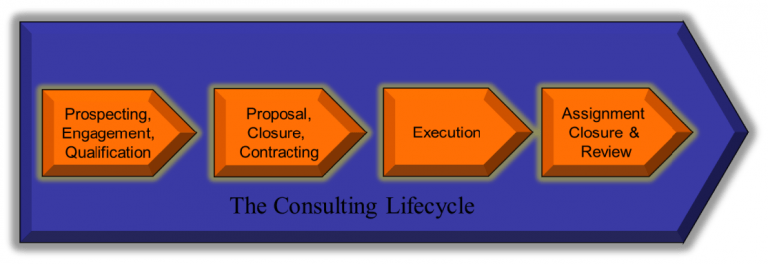
Without closure, all the preceding effort is meaningless. Successful consulting practices are also successful at closing the deal and asking for the business.
nProposal Presentation
n- n
- Prepare thoroughly. n
- Rehearse with the team. n
- Present the proposal, paying attention to:
o Roles u2013 who does what and who presents what.
o Process/ Approach u2013 highlight HOW you propose to address the client needs and produce the results and deliverables required.
o Benefits u2013 remember the business case which highlights costs, benefits and risks.
o Close by asking for the order. n
Prepare
n- n
- Test current position vs. your sales objectives. n
- Verify your clientu2019s buying process. n
- Plan for active participation and buy in. n
- Ensure the economic buyer is present (senior management, steering committee) u2013 (see client roles as well). n
- Prepare sales aids and have them available for quick access. n
- Plan the meeting.
o Identify and answer key questions, especially the difficult ones!
o Identify and counter objections before they are raised.
o Determine what the next steps are and what decision you require from the client.
o Ensure you prepare to walk away having achieved the key outcomes you are aiming for. n
Rehearse
n- n
- Rehearse and role-play the meeting. n
Presentation roles
n- n
- Consider the use of multiple presenters (expose the project team and its diverse capabilities). n
- Focus on utilising individual strengths in the presentation. n
- Identify the buying roles at the client and match presenters to each one. n
- Cover bases with all buying influences and styles. n
What to present
n- n
- Present the proposal and an implementation plan. n
- Present with all buying influences and styles in mind. n
- Assess and handle issues, concerns, questions and objections as they arise. n
- Ask relevant questions of the client to confirm details e.g. scope, timing and roles. n
- Probe for concerns/objections/issues over and above those specifically raised by the client. n
- Highlight benefits and added value (business case). n
- Confirm the clientu2019s desired/required results and ensure that your presentation is aligned to these. n
- Relate your own strengths to the client requirements. n
Close
n- n
- Close (do not negotiate fees at this stage). n
- Determine date(s) for reviews/decisions. n
- Agree next steps and responsibilities. n
- Meet later with economic buyer/s to obtain feedback and re-evaluate proposed approach if necessary. n
You may not be in a position to do all of the above depending on the rules and constraints applied by the client.
nQuestion: How seriously should an Internal Consultancy take this process? Note this for yourself
nHibbit Case Study: Presenting the proposal
nGo back to the Hibbit case study and use the guidelines in this section to prepare a formal proposal to obtain the work. You can work on your own or as a team. If you are working in a group, choose a presenter to present your proposal.

